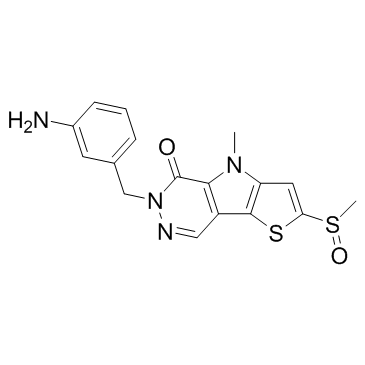| Description |
TEPP-46 is a potent and selective pyruvate kinase M2 (PKM2) activator with an AC50 of 92 nM, showing little or no effect on PKM1, PKL and PKR.
|
| Related Catalog |
|
| Target |
AC50: 92 nM (PKM2)
|
| In Vitro |
TEPP-46 and DASA-58 activate PKM2 by a mechanism similar to that of the endogenous activator FBP. Pre-treatment of cells with TEPP-46 or DASA-58 prevents pervanadate-induced inhibition of PKM2 activity. TEPP-46 also induces a decrease in the intracellular levels of acetyl-coA, lactate, ribose phosphate and serine[1]. TEPP-46 inhibits LPS-induced Hif-1α and IL-1β, as well as the expression of a range of other Hif-1α-dependent genes. TEPP-46 treatment significantly downregulates the expression of the M1 markers Il12p40 and Cxcl-10. Activation of PKM2 using TEPP-46 significantly inhibits FSL-1 and CpG-induced Il1b mRNA expression. TEPP-46 inhibits Mtb-induced Il1b mRNA levels, boosts Mtb-induced levels of Il10 mRNA, and has no effect on levels of Tnf[2].
|
| In Vivo |
TEPP-46 exhibits good oral bioavailability with relatively low clearance, long half-life, and good volume of distribution-parameters that predict for drug exposure in tumor tissues. TEPP-46 at 150 mg/kg readily achieves maximal PKM2 activation measured in A549 xenograft tumors[1].
|
| Kinase Assay |
Pyruvate kinase activity is measured by monitoring pyruvate-dependent conversion of NADH to NAD+ by lactate dehydrogenase (LDH) as described previously. Briefly, for cell line experiments, the medium is replaced with fresh medium 1 hour prior to the start of treatment with DMSO or activator. Also, where indicates, 100 μM pervanadate is added 10 minutes prior to cell lysis. Cells are lysed on ice with NP-40 buffer containing 2 mM DTT and protease inhibitors and clarified by centrifugation at 21,000 x g. 5 μL of the supernatant is used to assess pyruvate kinase activity. Pyruvate kinase activity is subsequently normalized for total protein content.
|
| Cell Assay |
2,000 cells are seeded in 96-well plates 24 h prior to treatment start. CellTiter96® AQueous is used to assess cell viability following oxidant and PKM2 activator combination treatments. MTS: (3-(4,5-dimethylthiazol-2-yl)-5- (3-carboxymethoxyphenyl)-2-(4-sulfophenyl)-2H-tetrazolium).
|
| Animal Admin |
H1299 parental and H1299 cells with constitutive expression of a mouse PKM1 cDNA (H1299-PKM1 cells) are propagated in RPMI supplemented with 10% fetal bovine serum, penicillin/streptomycin, 2 mM glutamine, and hygromycin for transgene selection. Cells are harvested, resuspended in sterile PBS, and 5×105 cells are injected subcutaneously into nu/nu mice. Tumor growth is monitored by caliper measurement, the mice are sacrificed and tumors harvested after the time indicated. Tumors are weighed, divided and either flash-frozen in liquid nitrogen or fixed in formalin for later analysis.
|
| References |
[1]. Anastasiou D, et al. Pyruvate kinase M2 activators promote tetramer formation and suppress tumorigenesis. Nat Chem Biol. 2012 Oct;8(10):839-847. [2]. Palsson-McDermott EM, et al. Pyruvate kinase M2 regulates Hif-1α activity and IL-1β induction and is a critical determinant of the warburg effect in LPS-activated macrophages. Cell Metab. 2015 Jan 6;21(1):65-80.
|
